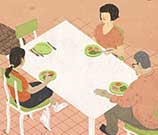|
|
 |
|
The
views expressed
on this page are soley those of the author and do not
necessarily
represent the views of County News Online
|
 |
NPR
How To Talk
With Kids About Terrible Things
Cory Turner
February 18, 2018
For the more than 3,000 students at Marjory Stoneman Douglas High
School, Wednesday's mass shooting was terrifying and life-changing. But
what of the tens of millions of other children, in schools across the
country, who have since heard about what happened and now struggle with
their own feelings of fear, confusion and uncertainty?
For their parents and teachers, we've put together a quick primer with
help from the National Association of School Psychologists and Melissa
Reeves, a former NASP president and co-author of its PREPaRE School
Crisis Prevention and Intervention curriculum.
Tune in
First, pay attention. Not just to what kids say, but what they do.
"Watch for clues that [children] may want to talk, such as hovering
around while you do the dishes or yard work," NASP recommends. "Some
children prefer writing, playing music, or doing an art project as an
outlet."
For younger children, drawing or imaginative play can help them give
voice to their fear, anxiety and other difficult feelings.
When the conversation starts ...
Emphasize: You are safe
"The cardinal rule when talking about this kind of tragedy with
children of all ages," Reeves says, "is for adults to reinforce the
safety efforts that their schools and the adults in their lives are
already taking to keep them safe."
Be specific, reminding them that's why the school doors are locked all
day and why they practice emergency lockdown drills.
Also, remind children and teens that, in spite of the headlines,
schools are still the safest place for them to be. Unfortunately,
Reeves says, this important message is undermined by relentless media
coverage; disturbing news and images of the Parkland shooting have been
ubiquitous (more on this later).
In its guidance, NASP offers this reminder: "Although there is no
absolute guarantee that something bad will never happen, it is
important to understand the difference between the possibility of
something happening and probability that it will affect you (our school
community)."
Let their questions be your guide
This is especially true for young children, who may know very little
about what actually happened but heard something on TV or glimpsed a
disturbing photograph online or in the newspaper.
"If students are saying, 'We heard something really bad happened at a
school yesterday,' keep it general," Reeves advises.
Ask, "What did you hear?"
If the child says, "Some kids got really hurt," you can respond
reassuringly but without unnecessary detail. Reeves suggests something
like this:
" 'Yes, some kids did get hurt, and here's what the adults are doing at
your school to make sure you stay safe.' "
For older kids who may know more details about the shooting — and that
many students were killed — it's important, Reeves says, to acknowledge
the tragedy and not make promises that you, as a parent or teacher,
can't keep.
Instead of saying, "I'm positive nothing bad will ever happen at your
school," walk them through the concrete steps being taken to ensure
their safety.
Control, control, control
A school shooting anywhere can make students everywhere feel powerless,
and that sense of helplessness can feed anxiety.
"What you want to do is give them a sense of control," Reeves says.
For young students, NASP recommends emphasizing simple examples of
adult-led school safety like "exterior doors being locked, child
monitoring efforts on the playground, and emergency drills practiced
during the school day."
These things should not only help a child feel safer but also give her
a sense of agency.
For older students, that list expands to include reporting strangers on
campus as well as potential threats made by classmates or members of
the immediate community.
Social media
One important risk for parents and teachers to keep in mind comes from
teens' exposure to social media. Disturbing photos and videos taken
during the Parkland shooting quickly began circulating.
For some teens, Reeves says, engaging with this kind of material can
cause what's known as secondary trauma. "Parents must monitor their
kids' social media use and give them permission to step away."
As an example, Reeves offers the story of her own daughter who, she
says, had been texting back and forth with friends after the school
shooting at Sandy Hook Elementary in Newtown, Conn. In that case, they
weren't sharing graphic images or news reports — just seemingly
harmless messages of grief and support.
But, Reeves says, with every new message coming in, she could sense her
daughter's anxiety level rising. And, she says, her daughter resisted
turning off her phone for fear that her friends would think she didn't
care.
"I find many students, when you explain to them that this can be
traumatizing and give them permission to step away, they're very
relieved," Reeves says.
Technology has eroded teens' boundaries, Reeves believes, making them
want to share everything over social media. Her message to them is
clear:
"This is not healthy. This is hurting you, and this could be hurting
your friends."
Note: Teachers and parents, how have you navigated difficult
conversations about tragedies like the Parkland school shooting? We'd
like to hear from you. Send us an email to npred@npr.org.
|
|
|
|

